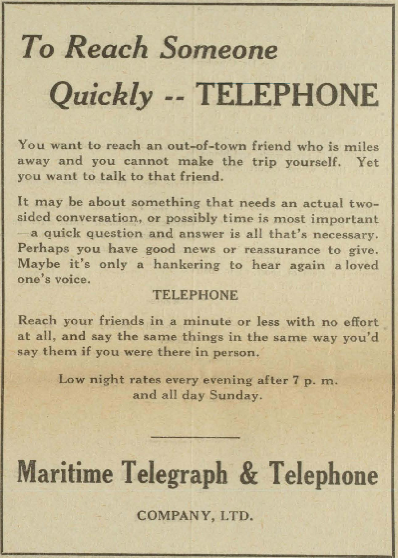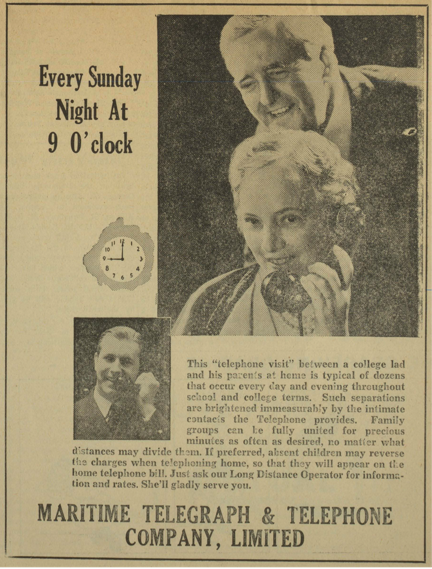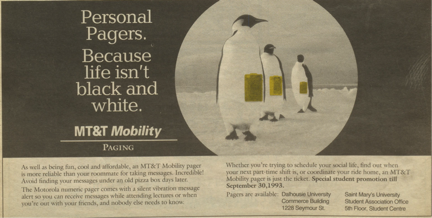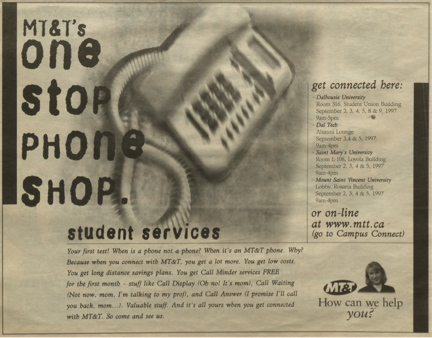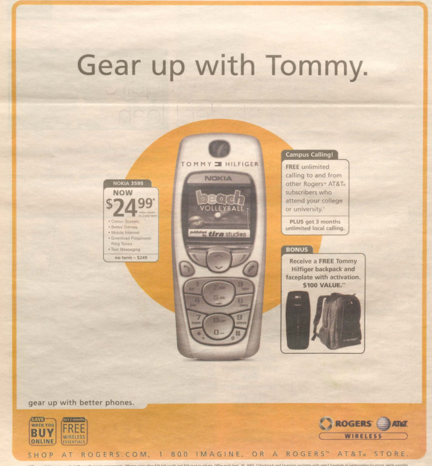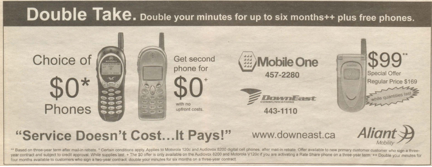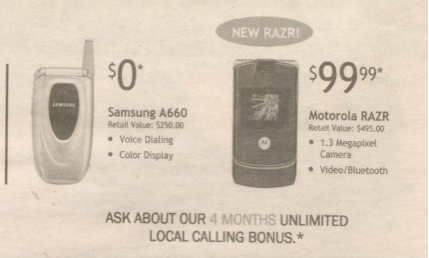
From the Archives: Telephones
A history of telephones on campus, from the first phone to the iPhone.
Over the past few weeks, we’ve witnessed the arrival of both the iPhone 6S and the Google Nexus 6P.
In honour of this latest clash in the smart-phone war for our hearts and dollars, let us take a look back at the evolution of student telephone use on campus — a history that stretches back well over a century before the first student ever Fruit Ninja’d their way through a dull class.
“College Notes” – Volume 26, Issue 1 – October 16, 1893
A TELEPHONE is much needed in the building. The idea of a University in a city of 40,000 inhabitants in the year 1893 with no means of communication with other sections of the town other than that supplied by the tardy means of locomotion provided by nature is preposterous. A telephone is as much a necessity as is a letter box. The Senate of Pine Hill College have taken this view of it, and it is certainly time for our Governors to wake up.
“Arts Valedictory” – F. Yorston – Volume 26, Issue 10 – May 7, 1894
[…]
A sport must have some subtle influence about it when it will constrain graduates of almost 30 years standing to leave their comfortable fireside, and travel a considerable distance to the telephone office through a heavy rainstorm, and patiently wait there no matter how long it may be, to hear the results of a foot-ball match. Our old Truro graduates are made of such stuff, and, probably those in many other places also.
“CA(T)CH-INN- ATIONS” – Volume 51, Issue 8 – March 26, 1919
Youthful Freshman trying to flirt with the telephone girl. “Hello central, give me Heaven!” She: “Look it up in the number book!”
“LOST” – Volume 51, Issue 6 – March 12, 1919
Why is Class ’20 like a telephone?
Because it’s always out of order.
The Great Phone Agitation of 1920
“Editorial” – Volune 52, Issue 3 – January 28, 1920
While not wishing to be to caustic in comments on college activities one might venture to inquire what action was taken by the United Students Council relative to the telephone that was to have been installed in the Murray Hometead. The prices were obtained for the same, but no telephone has put in an appearance, nor does it seem likely that it will do so during the present term.
“The Students’ Council” – Volume 52, Issue 13 – October 20, 1920
The final business to come before the meeting was a resolution that a telephone should be installed in the Forrest Building and in the Murray Homestead. This was passed and the Secretary was authorized to enquire into the matter and secure quotations and other information.
“The Students’ Council” – Volume 52, Issue 14 – October 27, 1920
The Secretary read a letter which he had received from the Telephone Company giving the rates for the installation of telephones in the Forrest Building and the
Murray Homestead. It was decided to have a pay station installed in the Murray Homestead, but owing to the fact that one is to be installed in the Forrest Building by the Pharmacy Department, the consideration of one for that building was left over until further information could be obtained.
“To the Editor, Dalhousie Gazette” – Volume 58, Issue 7 – December 3, 1925
Dear Sir:
Will you kindly allow me space in your publication to ask why it is that there is no telephone for the use of the students at Studley? Last year there was one installed in the gymnasium where it proved very useful and convenient. This year, however, the phone has disappeared.
Whether this was due to it being a commercial failure or to some whim on the part
of the University is not known. Surely it would be in the interests of the University as well as in the interests of the students, to have a students’ phone at Studley, since it would eliminate the bother of having students asking permission to use the phone in the University Office.
Something should be done in this matter and done immediately.
Thanking you, I am,
Yours sincerely,
“TOLL”
“Fact, Fables, Foibles” – Volume 68, Issue 2 – October 4, 1935
We like to read the advertisements. From such reading we learn much about life—what to wear and what not to wear, new cures and new ailments for these cures, and many startling announcements. By way of example we quote from a recent advertisement of the BELL TELEPHONE which carried this dramatic line: Telephone Communication With Anyone, Anywhere, At Any Time.
We admit that telephone service has improved greatly during the last few years but we think that the writer of the above line was exaggerating slightly.
At any rate, we know that he was not a Dalhousie man. Did you ever try to phone Shirreff Hall between 5.30 and 8.00 p.m.?
Volume 69, Issue 10 – November 27, 1936
Volume 72, Issue 1 – October 6, 1939
“The Old Order Changeth” – Mike Steeves – Volume 92, Issue 7 – November 18, 1959
“The old order changeth, yielding place to new.” Thus said Tennyson. And thus
said the Administration of Dalhousie when drawings were finalized and financing obtained for the new Men’s Residence, presently being erected on the northeast end of Studley campus.
Facilities will be many, comfort great, and food a far cry from that served now in our present canteen. No effort has been spared by the administration to ensure an atmosphere conducive to study and to the mental well being of those students “living-in”.
Total cost of building and furnishings will be about $1,500,000, according to last report.
(…)
Pay telephones will be provided on each floor in each wing. A buzzer system will be installed for the purpose of calling students from their rooms to the telephone. About 60 percent of the rooms will have a telephone outlet, enabling those who like privacy and hate money to have their own private line installed.
Volume 126, Issue 3 – September 16, 1993
The Growing Influence of Technology – Steve Tonner – Volume 126, Issue 7 – October 21, 1993
(…)
[R]emember your trusty address book, appointment book, calculator, watch, calendar, and expense reports? All these functions and more can be performed by something called a “Personal Digital Assistant”. These can come in the form of a calculator-sized instrument with plug-in ports for a printer and computer link (one of which I own, and am pleased to say the idea for this very article was first written on), with a full keyboard to boot, or a keyboard-less, large-screen version, of which the new Apple Newton is the most popular example. Some of the more expensive versions of these things even have a built-in cellular phone and can send faxes, all in a package measuring about 7 inches by 11 inches. And that’s not all. They can also recognize your handwriting, and soon, the designers hope, your voice as well.
And of course, we may all have heard that it’s not recommended for people to drive and talk on cellular phones at the same time? Try driving and typing at the same time. Take it from me, that’s hard.
Volume 130, Issue 1 – September 5, 1997
Volume 133, Issue 1 – September 7, 2000
Volume 136, Issue 3 – September 18, 2003
Volume 136, Issue 4 – September 25, 2003
Volume 138 – April 13, 2006
“Apples & Oranges” – Rafal Andronowski – Volume 139, Issue 16 – January 11, 2007
There were computers before the Mac came along, just as there were mp3 players before the iPod. But they don’t work half as well as the Apple products. Or look anywhere near as good.
And now Apple is at it again.
When the webpage finally refreshed and photos of the iPhone appeared, I was stunned. I skimmed over the features and spent a good 15 minutes staring in awe.
The iPhone, like the iPod before it, is a breakthrough in minimalist interface and design. All you need to operate the device is a finger or two.
No buttons, no little keyboards, just a large touch-screen. Clean, simple lines combine with high-tech styling and materials for a truly beautiful piece of technology.
Like the iPod, this is not a device to be shoved into a pocket or purse, only to be taken out for use. It’s a piece of modern art that happens to include some useful functions. In the iPhone, these functions include, among other features, email, voicemail, Google maps, a web-browser, a 2-megapixel camera, a built-in iPod for music, videos and photos, weather information and, of course, a phone.
Simply said, a cell phone, iPod and computer all rolled into one.
It’s uplifting to see that there are still companies out there willing to take some risks and design something different. Our lives are full of objects that largely look the same. Every PC laptop looks like a PC laptop. Every mp3 player looks like an mp3 player. Every smart phone looks like every other smart phone.
But take a look at the Macs, the iPods and, now, the iPhones. Each of these products can be picked out from afar because they are different and stand out.

